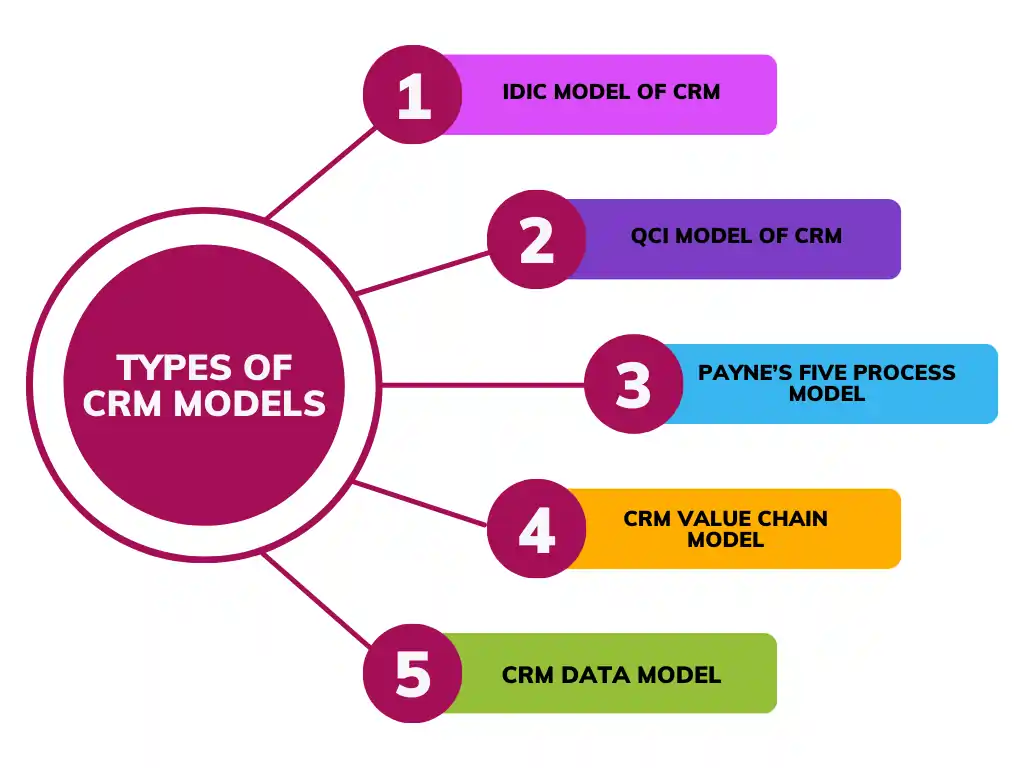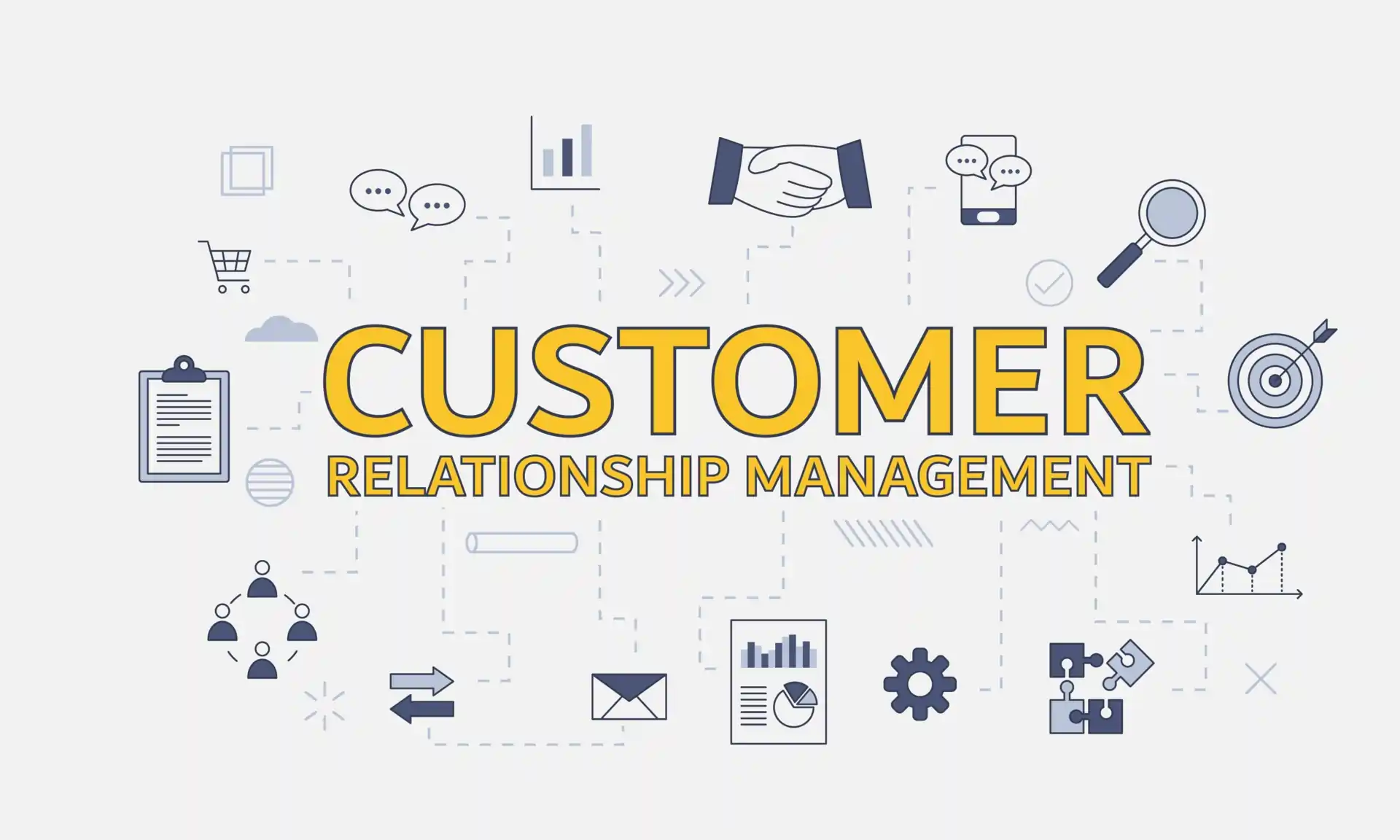Customer Relationship Management (CRM) is a crucial part of business strategy. CRM enables organizations to interact with customers more effectively and refine their processes. A CRM model is a strategy implemented to deal with customer relationships effectively. Organizations implement different CRM models to enhance customer experience, boost sales, and retain clients. In this blog, we will discuss customer relationship management models, their types, processes, advantages, disadvantages, and the impact of AI on CRM.
Table of Contents
ToggleWhat is a CRM Model?
A CRM model (Customer Relationship Management model) is a structured framework that businesses use to manage interactions with customers, improve relationships, and drive customer loyalty. It defines strategies and processes for acquiring, engaging, and retaining customers. Popular CRM models include the IDIC Model, QCI Model, and Payne & Frow’s CRM Model, each catering to different business needs.
CRM models help businesses understand customers, customize services, and facilitate customer satisfaction. They also help business firms segment customers, streamline their marketing strategies, and enhance functional effectiveness.
Key Objectives of CRM Models:
- Customer Segmentation: Grouping customers based on behaviour or value.
- Personalization: Tailoring interactions to meet individual needs.
- Optimization: Refining internal processes for better efficiency.
- Retention: Building long-term relationships with high-value customers.
Why CRM Models Matter
The customer relationship management model is significant in that it provides a platform for businesses to:
- Enhance customer satisfaction through tailored interactions.
- Increase sales by identifying opportunities and nurturing leads.
- Improve retention by fostering loyalty.
- Use data to make informed decisions.
Improve customer satisfaction through personalized interactions.
Increase sales by identifying opportunities and assisting prospective customers.
Types of CRM Models
Various customer relationship management models exist designed to address a specific aspect of customer interaction. This article will overview some of the most popular CRM models, their features, examples, and applications.

1. The IDIC Model of CRM
Developed by Peppers & Rogers Group, IDIC stands for Identify, Differentiate, Interact, and Customize. The IDIC CRM Model by Peppers & Rogers Group is a customer-oriented approach that establishes solid, individualized customer relationships to enhance loyalty and lifetime value. It is most commonly applied in Customer Relationship Management (CRM) to develop a more customized customer experience.
This model is like having a personal shopper who knows exactly what you need.
Identify: Pinpoint leads and customers by gathering data like purchase history and preferences.
Differentiate: Segment customers based on their values and needs, ensuring each group receives tailored attention.
Interact: Engage with customers through personalized communication strategies that resonate with them.
Customize: Adapt offerings to meet the specific requirements of each segment, making them feel truly understood.
Example: An online streaming platform such as Netflix recognizes customers by their profiles, segments watching behaviour (e.g., binge-watchers vs. occasional viewers), communicates through targeted emails, and tailors content recommendations based on watch history. The IDIC model CRM is very good at one-to-one marketing.
2. The QCI Model of CRM
The QCi Model is a customer relationship management (CRM) model based on business strategy and customer processes that aims at boosting profitability and retention. The model differs from typical CRM models with an overreliance on technology because people, processes, and strategic planning are highlighted.
Founded by the QCI (Quality Competitive Index) Group, this model identifies customer management as a business strategy rather than merely as a technology-driven task.
Features:
- Customer Proposition: Describes the distinctive value that a business provides (e.g., high-quality products, price, or convenience).
- Customer Management Activity: Involves activities to deal with customers, like support, sales, and follow-up.
- Measurement: Entails monitoring performance indicators (e.g., customer satisfaction ratings, retention percentages) in order to enhance strategies.
3. Payne’s Five Process Model
Developed by Adrian Payne, Payne’s Five Process Model is a well-delineated CRM process model that ties the CRM strategy to the corporate plan. The components of its composition are:
- Strategy Development: Determining the game plan—i.e., “Let’s get our regulars to love us even more.”
- Value Creation: Ensuring you receive awesome things (such as promotions) and they receive your loyalty in return.
- Multichannel Integration: Making it all flow smoothly whether you’re shopping online, in person, or on your phone.
- Information Management: Gathering information about you (don’t worry, it’s to improve things!).
- Performance Assessment: Testing if it’s working—like, “Are people happier now?”
Real Talk: Imagine a clothing store applying this relationship management model. They match your online wishlist with their app, give you a discount code, and check in on how your last purchase was—all to keep you styling.
4. CRM Value Chain Model:
The CRM Value Chain Model is a strategic model that guides companies to develop value for customers while being profitable. Francis Buttle created this model, combining internal and external processes to leverage customer relationships.
Key Steps:
- Customer Portfolio Analysis: Determine strategically important customers (SSCs) by value and behaviour.
- Customer Intimacy: Learn customer profiles and likes to tailor interactions.
- Network Development: Develop relations with suppliers, partners, and stakeholders to provide value.
- Value Proposition Development: Design customized products that serve customer needs.
- Manage Customer Lifecycle: Drive the journey from prospect to advocate.
CRM Value Chain Model Example:
An example of a customer management model that a meal kit company could utilize. They identify their loyal foodies, send one a free dessert, partner with local farms for ingredients, and check in with you to keep cooking.
5. CRM Data Model
CRM data models can be classified under four broad types depending on functionality: Operational CRM, Analytical CRM, Collaborative CRM, and Strategic CRM. Each category has a separate role to play in handling the customer relationship as well as aligning business operations
The CRM data model is the resident nerd hero without which CRM functions. It is all about storing information—e.g., name, what you purchased, how you grip, making it convenient.
- Data Organization: Ensures information is categorized (e.g., demographics, interactions).
- Accessibility: Makes data available for analysis or automation.
- Scalability: Supports growing datasets as the business expands.
Use Case: A bank could use a schema model in CRM to link a customer’s account information, loan requests, and transaction history, allowing employees to provide personalized financial recommendations in real-time.
5 Models of CRM by Functionality
Beyond specific frameworks, CRM is often categorized into five models of CRM based on functionality:
- Operational CRM: Automates day-to-day tasks (e.g., sales pipelines, customer support ticketing).
- Analytical CRM: Uses data analytics to predict trends and segment customers.
- Collaborative CRM: Facilitates communication between departments, partners, and customers.
- Strategic CRM: Focuses on long-term customer-centric strategies.
- Social CRM: Integrates social media platforms for engagement and feedback.
These customer relationship models can overlap or be combined for a tailored approach.
Start reading! 5 main types of CRM software
Components of Relationship Management
Regardless of the model CRM, certain components are universal:
- Customer Data: The lifeblood of CRM—names, contact info, behaviours, and more.
- Technology: CRM software, databases, and analytics tools.
- Processes: Defined workflows for sales, marketing, and support.
- Interaction Channels: Email, phone, chat, social media, and in-person touchpoints.
- People: Trained employees who execute the CRM strategy.
These elements enable digital customer relationship management, ensuring businesses thrive in a digital-first era.
“Looking for the best CRM software for your business? Check out our guide on Best CRM Programs for Small Business in 2024-25!”
Pros and Cons of Customer Relationship Management
Pros:
- Enhanced Customer Experience: Personalization increases satisfaction and trust.
- Operational Efficiency: Automation reduces manual workloads (e.g., scheduling follow-ups).
- Actionable Insights: Data reveals opportunities for growth and improvement.
- Revenue Growth: Loyal customers spend more and refer others.
Disadvantages of CRM:
- High Costs: CRM pricing models range from affordable subscriptions to enterprise-level investments, plus implementation fees.
- Complexity: Integrating systems and training staff can take months.
- Data Security Risks: Mishandling sensitive information risks breaches or legal penalties.
- Resistance to Change: Employees may struggle with new tools or processes.
Integrating AI into CRM
Artificial intelligence is reshaping AI into a CRM business model. Integrating introduces powerful capabilities:
- Predictive Analytics: AI forecasts purchasing patterns or churn risks using historical data.
- Automation: Chatbots handle FAQs, freeing staff for complex tasks.
- Hyper-Personalization: Machine learning tailors offers based on real-time behaviour.
- Efficiency: AI processes massive datasets faster than humans ever could.
Example: A travel company could employ AI in its CRM model to scan booking patterns, forecast peak periods, and automatically send customized holiday packages to clients—increasing conversions with little effort.
CRM Pricing Models
Different CRM pricing models allow businesses to choose solutions based on their budget and requirements:
- Subscription-Based Pricing: Monthly or annual payments based on user count or features.
- Per-User Pricing: Costs increase with the number of users accessing the CRM.
- Feature-Based Pricing: Pay only for required functionalities.
- Freemium Models: Free basic features with paid premium upgrades.
- Enterprise Pricing: Custom pricing for large-scale organizations.
A CRM Model in Real Life
Let’s make it real with a CRM model example using the IDIC model:
- Identify: A pet store knows you’re the one buying cat treats every month.
- Differentiate: They see you’re a cat parent, not a dog walker.
- Interact: They text you a coupon for kitty litter.
- Customize: They recommend a new fish-shaped toy your cat will flip for.
Conclusion
Every CRM model has a different function, depending on what the business wants and how it intends to approach customers. The IDIC Model prioritizes personalization, the QCI Model concentrates on customer value, and Payne & Frow’s Model incorporates strategic and operational CRM. In contrast, Gartner’s 8 Building Blocks assist big businesses in organizing their CRM strategy well.
